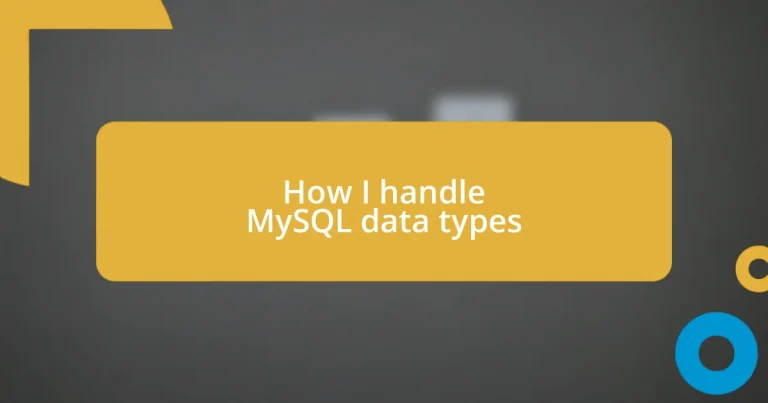Key takeaways:
- Choosing the appropriate MySQL data type is essential for optimizing performance and storage efficiency, as improper selections can lead to complications and slow queries.
- Understanding the nuances of numeric, string, and date/time data types is crucial for maintaining data integrity and ensuring accuracy, especially in situations like financial calculations.
- Avoid common pitfalls, such as using VARCHAR for fixed-length data or not accounting for character encoding, to enhance database performance and user experience.
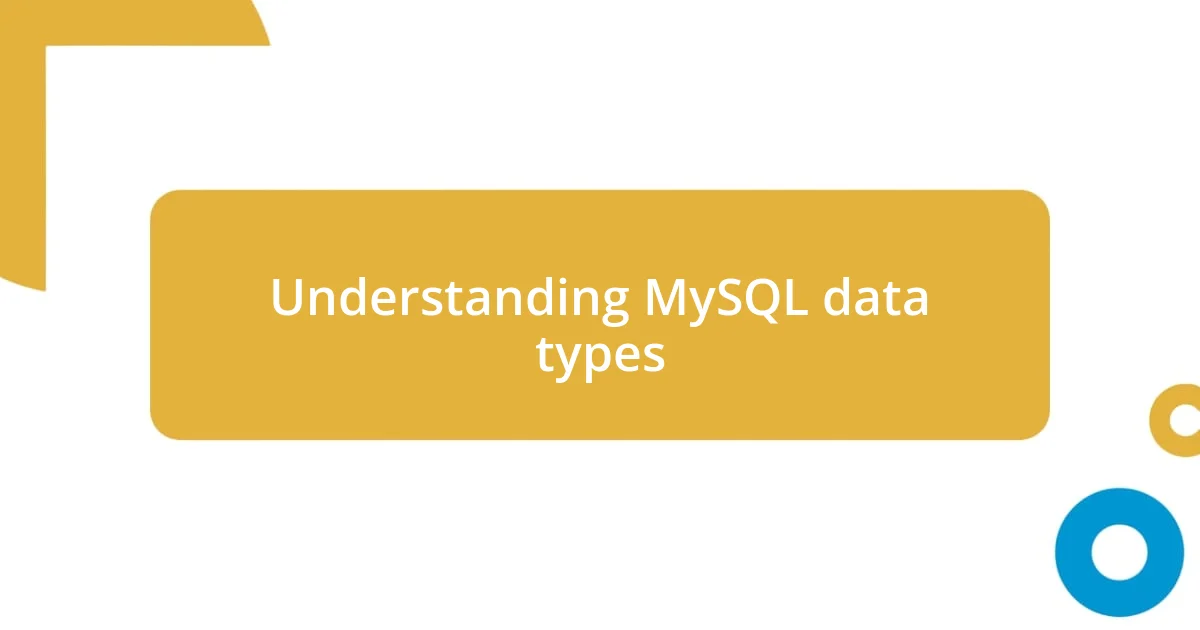
Understanding MySQL data types
Understanding MySQL data types is crucial for building efficient databases. When I first started working with MySQL, I made the mistake of using the wrong data type for certain columns, which led to performance issues. Have you ever had to troubleshoot unexpected errors? It’s often the little things, like not selecting the optimal data type, that can trip you up.
In MySQL, data types are categorized into several groups, including numeric, date and time, and string types. I remember a project where I misused VARCHAR instead of TEXT for a field that required large entries. When dealing with user-generated content, choosing the right type can save you from unexpected complications later on. Can you imagine waiting for a lengthy query just because of a data type oversight?
Lastly, understanding the nuances of these types allows for better memory management and can lead to increased performance. I find that taking the time to analyze the data requirements at the start can save countless hours of debugging down the line. As you delve deeper into MySQL, consider how data types impact not just your queries, but the overall health of your database.
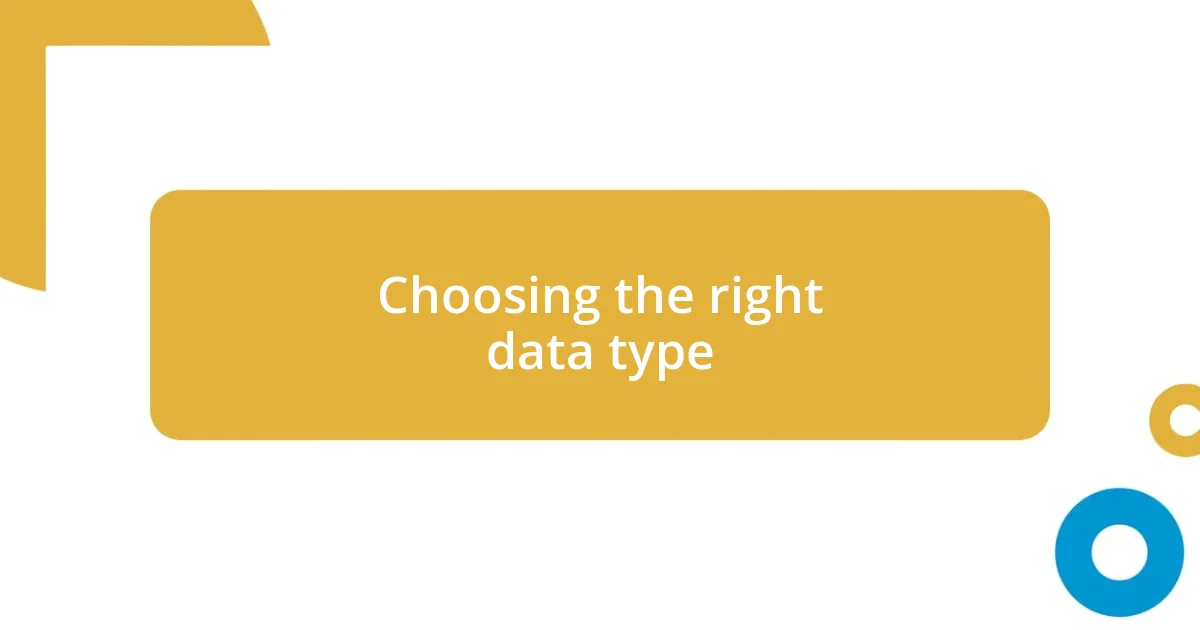
Choosing the right data type
Choosing the right data type can significantly impact both performance and storage efficiency. Early in my career, I once used an INT data type for a column that was meant to hold small numeric values, thinking it would be appropriate. Later, I learned that using TINYINT would have sufficed and saved memory. It was a bit of a lightbulb moment for me, emphasizing the need for tailored data types in line with actual requirements.
To ensure you’re selecting the most efficient data type, consider these aspects:
- Data Size: Evaluate the potential range of values or text length you’ll need. Don’t go for larger types if smaller ones will work.
- Usage Frequency: Think about how often the data is accessed and manipulated. Some types perform better under heavy usage.
- Indexing: Understand how the choice affects indexing, as certain data types can slow down your query performance if not chosen wisely.
- Normalization: Consider how this data will relate to others in your database, as certain types might be better suited for relationships with other tables.
- Future Needs: Anticipate any future changes in requirements as business needs evolve, allowing room for scalability.
I’ve learned that it’s not just about meeting current needs; it’s also about being ahead of the game. Each choice builds a foundation that impacts not just one query, but potentially thousands of them.
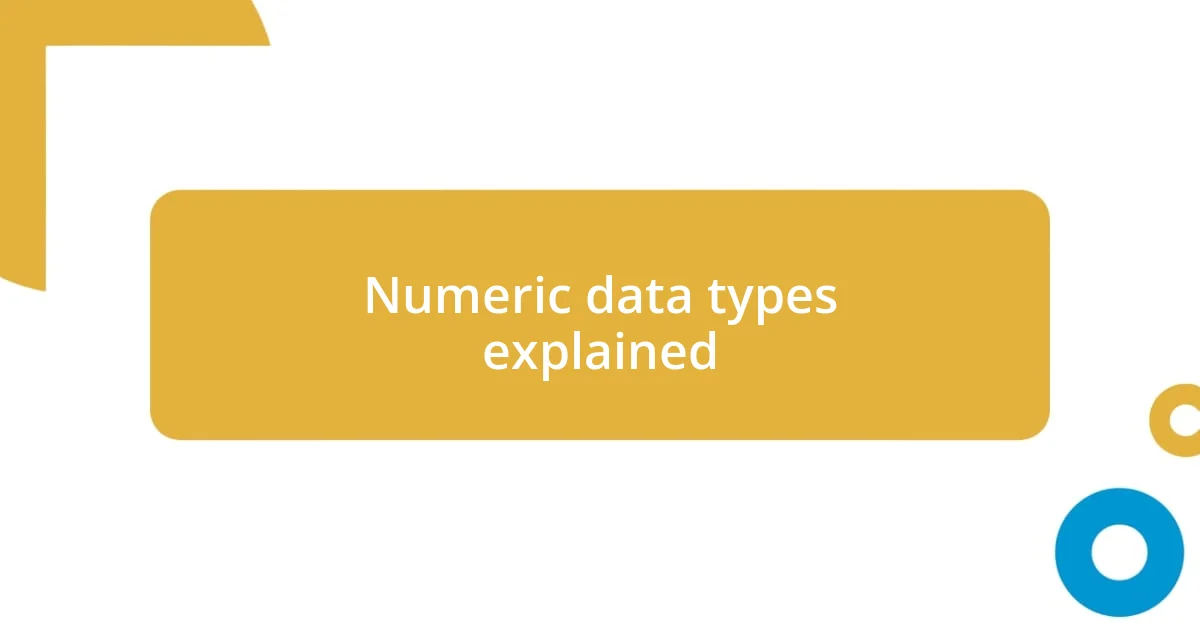
Numeric data types explained
Understanding numeric data types in MySQL is essential since they dictate how numbers are stored and manipulated in databases. Initially, I thought all numeric types were interchangeable, but I quickly learned that choosing between types like INT, DECIMAL, and FLOAT can significantly affect accuracy and performance. For instance, one time I used FLOAT for financial data, which resulted in unexpected rounding issues—not ideal when cents are on the line!
The way I conceptualize numeric data types is largely influenced by the range of values they can store. For example, while INT can hold quite large integers, it may not always be the best fit—especially if you’re working with smaller numbers. This is why I often lean toward using TINYINT for small ranges, which conserves space and enhances performance. Have you ever evaluated the range of your numbers only to realize a smaller type would deliver better results?
It’s also important to consider the precision of numeric data types when it comes to calculations. DECIMAL is a fantastic choice for tasks requiring exact precision, such as currency transactions. I remember an incident where I mistakenly opted for FLOAT, which caused discrepancies in billing due to its handling of decimal places. This experience taught me that the right numeric data type is not just a technical choice; it’s about maintaining the integrity of your data.
| Data Type | Storage Size |
|---|---|
| TINYINT | 1 byte |
| SMALLINT | 2 bytes |
| MEDIUMINT | 3 bytes |
| INT | 4 bytes |
| BIGINT | 8 bytes |
| FLOAT | 4 bytes |
| DOUBLE | 8 bytes |
| DECIMAL (M,D) | Varies |
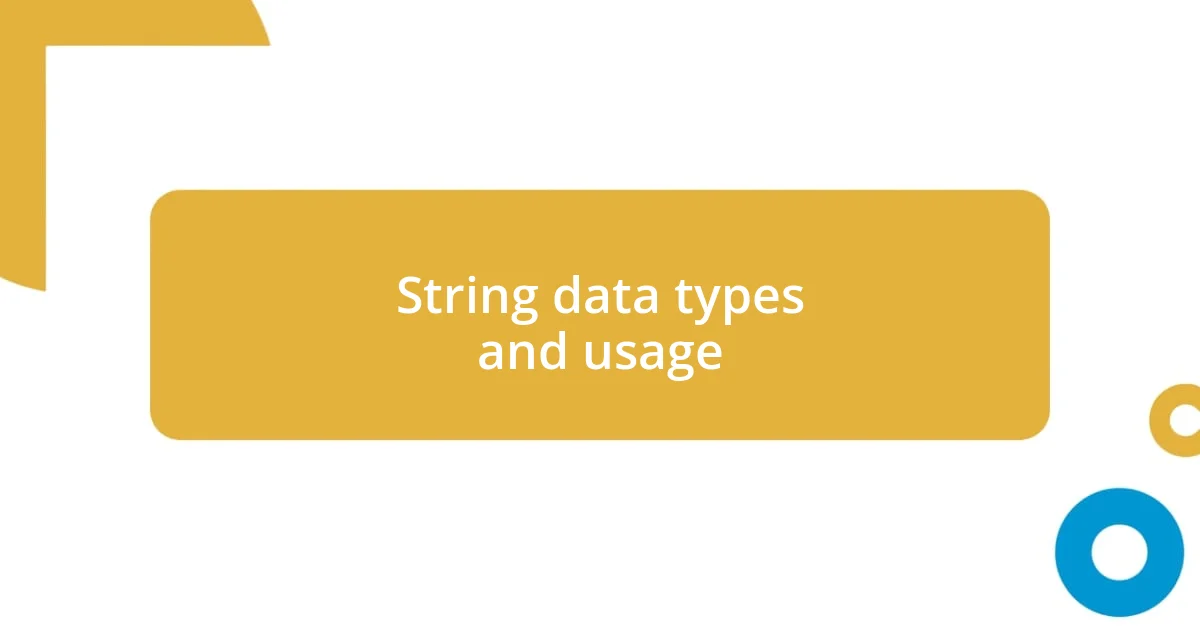
String data types and usage
String data types in MySQL play a vital role in how text is stored and processed, directly influencing both storage efficiency and performance. In my early days, I often defaulted to using VARCHAR for everything, assuming its flexibility was best. However, I’ve since discovered that CHAR can be a better fit for fixed-length data, minimizing storage overhead and optimizing performance. Have you ever considered how seemingly small choices about string types can ripple through an entire database?
Now, let’s talk about character sets, which are crucial for maintaining data integrity, especially in multilingual applications. I once had a project where I neglected to specify the UTF-8 character set, leading to garbled text for users who entered non-ASCII characters. This experience reinforced the importance of understanding how character encoding affects string data. Choosing the right character set not only enhances application performance but also improves user experience—something that’s easy to overlook!
Additionally, I’ve found that the choice between using TEXT and VARCHAR comes down to understanding your actual data size and use case. While TEXT allows for larger amounts of text, the trade-off is a potential performance hit and limitations on indexing. I vividly recall a scenario where I took a leap and used TEXT for user comments, only to realize later how it slowed down queries when accessing popular posts. Reflecting on this, I now always assess whether VARCHAR can handle the expected length, ultimately leading to a smoother and faster user experience.
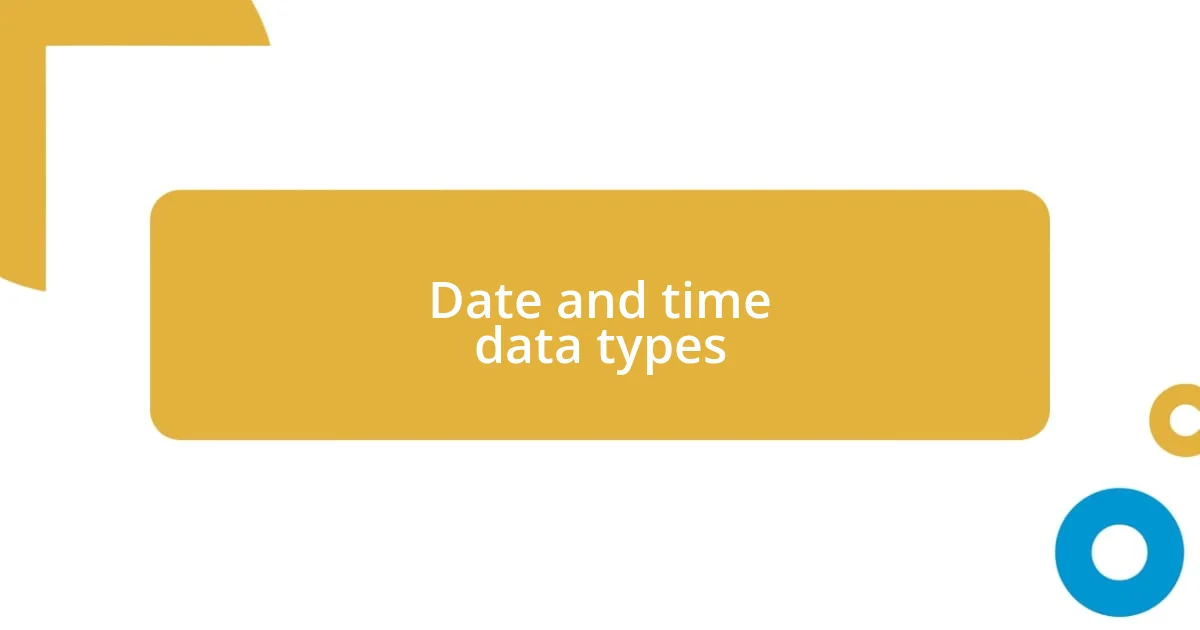
Date and time data types
Understanding date and time data types in MySQL can feel overwhelming at first, especially when you consider the precision and variety they offer. I vividly remember when I first encountered the DATE and DATETIME types. I mistakenly thought they were interchangeable, but I quickly learned through trial and error that using DATETIME for operations requiring just the date led to unnecessary complexity—and a lot of confusion. Have you ever gone down a similar rabbit hole with data types?
When it comes to DATE, I find it incredibly efficient for tracking events without the need for time. I recall managing a project involving deadlines where using DATE simplified my queries significantly. It helped keep my data clear and focused on what mattered: the day. On the flip side, I now reserve DATETIME for logging actions that occur down to the second. That shift has saved me from potential data disasters in applications where timing is crucial. It makes me wonder how many times we overcomplicate things when a simpler data type will do!
Additionally, understanding TIME and TIMESTAMP has been a game-changer for me. I once developed a feature where users could see how long ago things happened, using TIMESTAMP to track changes. This not only enhanced user experience but also allowed me to display relative times, like “3 days ago”. It’s fascinating how these little details can create a more engaging application! I often remind myself that the right choice in data types doesn’t just simplify my database design; it also enriches the overall experience for users. How do you manage time in your projects?
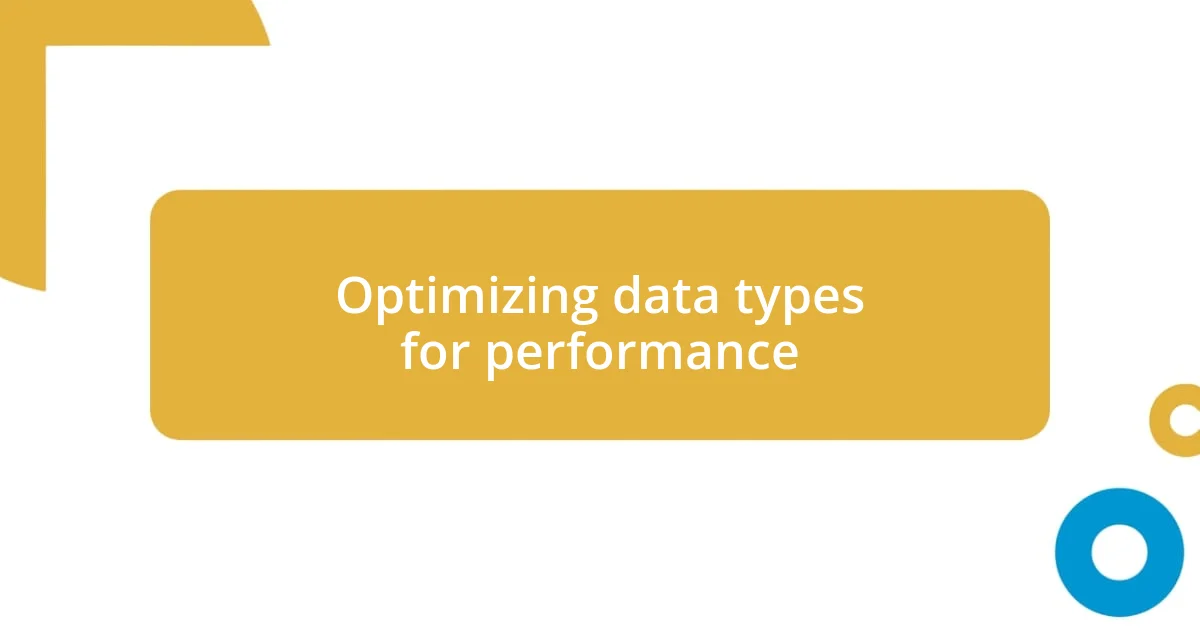
Optimizing data types for performance
Optimizing data types is one of those essential yet often overlooked aspects of MySQL performance. I remember diving into a project where I opted for INT over BIGINT for user ID fields, only to later realize the dataset was growing faster than anticipated. It was a simple choice that drastically improved performance, ensuring my queries executed smoothly as the database scaled. Have you considered how even minor adjustments, like moving from a larger to a smaller data type, can yield significant benefits?
Another crucial lesson I’ve learned is the impact of selecting the right numeric data type based on purpose. When I first approached financial data, I unwittingly used FLOAT for currency values, leading to rounding errors that caused confusion in reports. Switching to DECIMAL corrected this mistake and maintained precision in calculations. Think about it—how often do we sacrifice accuracy for convenience when a well-considered choice could save us headaches later on?
Moreover, I’ve come to appreciate the power of NULL values in performance tuning. Ignoring NULL could lead to unnecessary storage waste and slower query performance. In one project, I experienced a notable lag simply because I neglected to define an integer column as NOT NULL where appropriate. Implementing constraints improved performance and data integrity. It’s a reminder of how a little attention to detail in data types can save time and resources down the line. Are you making the most of NULL when optimizing your database?
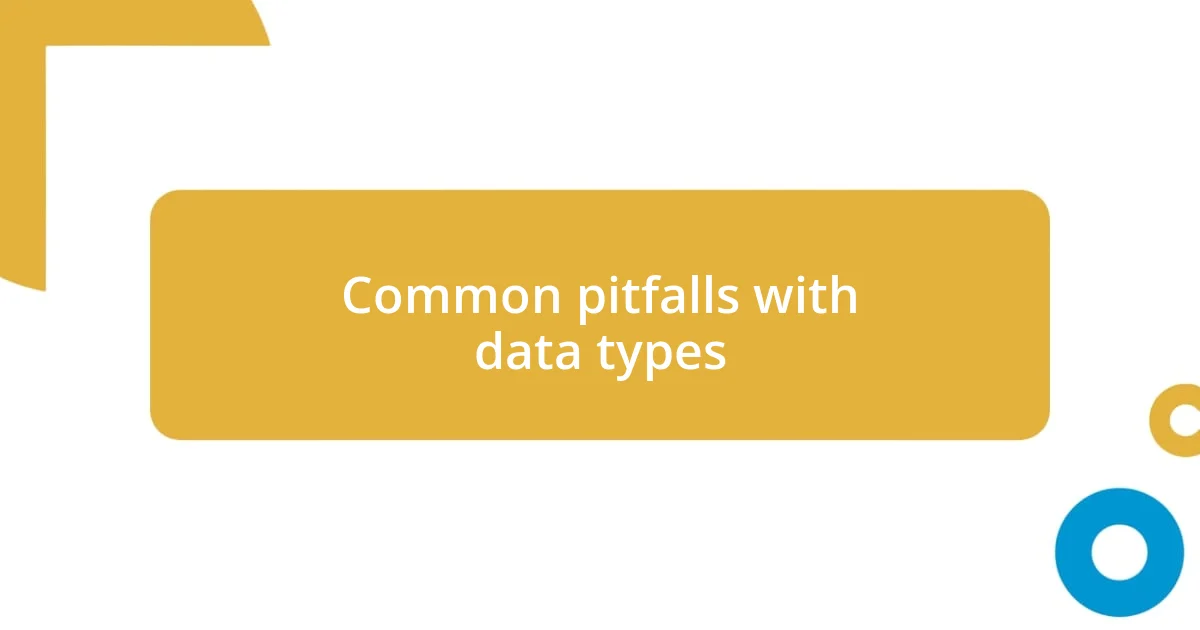
Common pitfalls with data types
When dealing with common pitfalls in MySQL data types, a significant mistake I’ve encountered is the use of VARCHAR for fixed-length data. In one of my earlier projects, I chose VARCHAR(50) for a column that was consistently storing 10-digit phone numbers. The result? I ended up wasting storage space and complicating my queries for no good reason. Leveraging CHAR instead would have streamlined everything. Have you ever made a similar choice that seemed minor at the time but led to greater issues later on?
One particularly tricky situation arose when I failed to consider character encoding. I once worked with a dataset containing international names and decided to go with the default character set. This oversight caused my application to display garbled characters for certain inputs. The moment I switched to utf8mb4, I felt a wave of relief wash over me as I finally could capture the true essence of the data without compromising integrity. It’s incredible how something as fundamental as character encoding can slip through the cracks. Are you mindful of how character sets can impact your data representation?
Lastly, another common pitfall is overlooking the implications of data types on indexing. I recall a project where I assumed that using TEXT types would work seamlessly with my indexing strategy. Unfortunately, I soon discovered that it led to slower performance in queries, diminishing the overall speed of my application. Changing the data type to a more appropriate choice often resolves such issues. How often do you think about the relationship between data type selection and your database performance? It’s a crucial consideration that can make all the difference.












